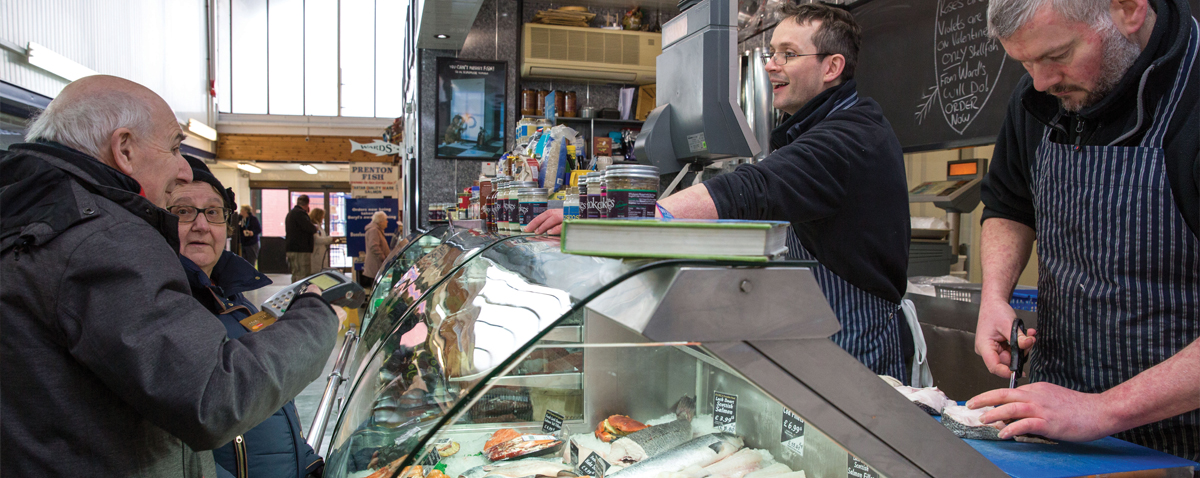Let’s capitalise on our undervalued assets
Birkenhead Market has always been the beating heart of the town… can we make it even better?
Chosen as one of the very first Marks and Spencer Penny Bazaars (back in 1840), Birkenhead Market traded successfully for the best part of two centuries. Through the years, it’s been the starting point for many of the town’s best-loved businesses. The country produce, the glistening fish, the handbags and gladrags. If we wanted it, the market had it.
Which is probably why, today, shoppers flock here from near and far. Even, whisper it, Rhyl…
The town has shifted around it, supermarkets have come and gone (and come again!), and it was even engulfed in flames. But Birkenhead Market has beaten off all competition, and we’re determined to keep it that way.
In Birkenhead, we know that a good market is as much about grabbing a deal as it is catching up on the gossip. Our families have their favourite stores. Their Saturday morning rituals. These days, cities around the world are beginning to realise how placing a market at the heart of things is the smart thing to do.
But it’s something we always knew. Because, unlike many other towns, we never turned our back on our market. How many towns can boast two centuries of continuous trade? Birkenhead can. From Sheffield to San Francisco, Bury to Bilbao – markets have brought life, character and business back to the heart of their retail offer. We know how to do this. We’re already doing it. But we think we can make it better. By building on two hundred years of trading, Birkenhead can be a modern market town to be proud of.
Market traders going the extra mile
There is a new breed of market trader in Birkenhead – one that defiantly shows this place has a future at the heart of the town. Since 1927, Wards has been serving the good people of the parish with just-landed fish.
Today, Nigel, pictured above, and Simon Buckmaster are the fourth generation of the family – one of only four remaining fishmongers on Merseyside.
On any given market day, there’ll always be a hubbub of activity around their spic-and-span stall – now with a huge crab and lobster tank, and bewildering variety of game meats, tubes of Stornoway black pudding and freshly made sauces. But it’s all about the fish. And, for Nigel, it’s all about the service too.
“For a long time, markets were all about a race to the bottom – about grabbing a bargain, getting stuff on the cheap. You can’t do that any more. The high street’s become the market, with its Home Bargains and Poundlands. Now it’s about going the extra mile, helping your customers learn how to cook, giving them the very best produce.
“You’ll see if you look around, the busiest stalls are like industrial units. There’s a shop front, where staff engage with their customers, but often, at the back, they’ve a thriving online business too.
“People don’t come to Birkenhead to browse all day – why would they when there’s Liverpool ONE? But they do come to destination shops, places like ours and a handful of others in the market,” he says.
But one thing is clear: the market is too big. “It was built for a different era. We need to slim back, and focus on quality,” he says. “I don’t buy that talk of Birkenhead being poor. People here are canny with their money, but it’s about quality, not price. We’ve grown as a business by going up in quality, not down.”
Case study Altrincham Market
Altrincham, one of the country’s few genuinely planned market towns, got into trading way back in 1290. But, by the 1980s, the town’s market was a neglected, little-used reminder of the past. Bar owners, Nick and Jenny Thomson thought they could do better. After extensive talks with their Council, they were given the chance to prove it.
“Altrincham needed to reinvent itself as a modern market town,” Nick recalls. “The town I lived in wasn’t fit for purpose. It had the highest retail vacancy rate in the north. The market was dying. We needed a place where people could meet, be warm and get fed,” Jenny says of her idea to reimagine the market hall as a thriving food hub. “This place sold toilet rolls and knickers,” she says. “Last week, we fed 7,000 people!”
The hall is ringed by bright new businesses – pizza, sausage makers, bread and ale. Outside, in the covered market, traditional traders ply their wares alongside new made-in-Altrincham start-ups. They started on Sundays with the food court – now open five days a week, into the evening.
They’ve injected 19 new businesses, 73 permanent new jobs and a turnover of £3.5 million a year into the local economy. For the price of, what? “Less than half of what it’d cost to build a new Lidl!”



